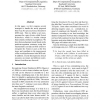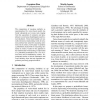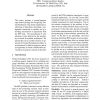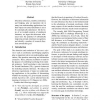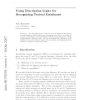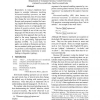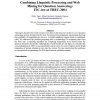102
Voted
EMNLP
2009
14 years 10 months ago
2009
In this paper, we first compare several strategies to handle the newly proposed three-way Recognizing Textual Entailment (RTE) task. Then we define a new measurement for a pair of...
124
click to vote
ACL
2009
14 years 10 months ago
2009
We present a graph-based semi-supervised learning for the question-answering (QA) task for ranking candidate sentences. Using textual entailment analysis, we obtain entailment sco...
109
Voted
EMNLP
2010
14 years 10 months ago
2010
The computation of meaning similarity as operationalized by vector-based models has found widespread use in many tasks ranging from the acquisition of synonyms and paraphrases to ...
103
Voted
ACL
2010
14 years 10 months ago
2010
This paper presents a general-purpose open source package for recognizing Textual Entailment. The system implements a collection of algorithms, providing a configurable framework ...
102
Voted
ACL
2010
14 years 10 months ago
2010
We challenge the NLP community to participate in a large-scale, distributed effort to design and build resources for developing and evaluating solutions to new and existing NLP ta...
112
click to vote
ACL
2010
14 years 10 months ago
2010
Discourse references, notably coreference and bridging, play an important role in many text understanding applications, but their impact on textual entailment is yet to be systema...
138
click to vote
MICAI
2010
Springer
14 years 11 months ago
2010
Springer
We present our experiments on Recognizing Textual Entailment based on modeling the entailment relation as a classification problem. As features used to classify the entailment pair...
102
Voted
CORR
2007
Springer
15 years 17 days ago
2007
Springer
The aim of this paper is to show how we can handle the Recognising Textual Entailment (RTE) task by using Description Logics (DLs). To do this, we propose a representation of natur...
116
click to vote
CORR
2010
Springer
15 years 20 days ago
2010
Springer
Researchers in textual entailment have begun to consider inferences involving downward-entailing operators, an interesting and important class of lexical items that change the way...
122
Voted
TREC
2004
15 years 1 months ago
2004
This paper describes the work we have been done in the last year on the DIOGENE Question Answering system developed at ITC-Irst. We present two preliminary experiments showing the...
